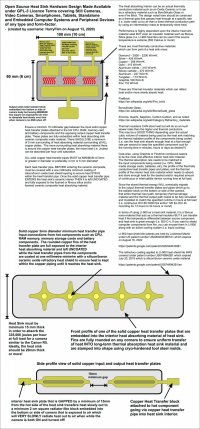Harry
I have completely misunderstood your design and its concepts. The LI-900 you propose to use is a a very efficient insulator of very low thermal capacity, so it isn't a heat sink, it just greatly slows down heat transfer without absorbing heat. If it surrounds copper, it will keep the copper hot, and if the copper is in contact with the heat producing components, it will keep them hot. So please explain what is going on so even I can understand it.
Thanks
OOOOPS !!!! --- I must bow down to your notes about the problems with my earlier proposed heat sink design.
I put it out there for giggles mostly until my actual degree-carrying colleague reviewed it on the weekend and made it known to me after noting your detail that yes the LI-900 fibrous silica tile material would be an insulator of the copper heat transfer plates and pipes and would stay hot as will the components such as CPU, RAM, memory card, battery, etc.
It seems if you use FIBROUS silica (or any other fibrous material), very little heat transfer would take place as it becomes an insulator. The heat transfer would NOT be fast enough from the component to the interior of the heat sink to cool the CPUs and/or any other camera components just as you outlined earlier!
My earlier design would ONLY WORK once temperatures quite exceeded hundreds of degrees kinda frying the camera cpus. Evidently, this design, if you used LI-900 as the heat sink material, ONLY WORKS for spacecraft or for environments where huge heat differentials are required for the LI-900 tile to act heat-sink-like. (i.e in excess of 500 Celcius!).
You need to use a more modern thermally conductive material such as those below as the thermally absorbent interior heat sink material:
Diamond – 2000 – 2200 W/m•K. ...
Silver – 429 W/m•K. ...
Copper – 398 W/m•K. ...
Gold – 315 W/m•K. ...
Aluminum nitride – 310 W/m•K. ...
Silicon carbide – 270 W/m•K. ...
Aluminum – 247 W/m•K. ...
Tungsten – 173 W/m•K.
Graphite 168 W/m•K
Zinc 116 W/m•K
or
Carbon-Carbon Ceramic Composite
Borosilicate Glass
Fire Brick Compound
Porcelain Ceramic
Anyways, a revised version of the design is noted with the changes using more contemporary heat sink material such as actual Carbon-Carbon composite, Solid BoroSilicate Glass or even Fire Brick or Porcelain ceramic compounds!
Soooooo, I DO MUST SAY OOOOPS! That was my earlier mistake!
P.S. Hey Canon! WHERE is our f/4-to-f/5.6 135mm-to-650mm Sports Zoom Lens in RF, EF mount and PL mount? (along a removable rocker-switch zoom/iris/focus servo motor handgrip!)
Oh Well --- ONTO THE NEXT DESIGN OF MINE! ;-)

;-)
V

